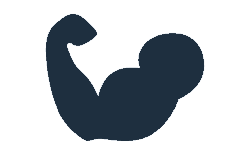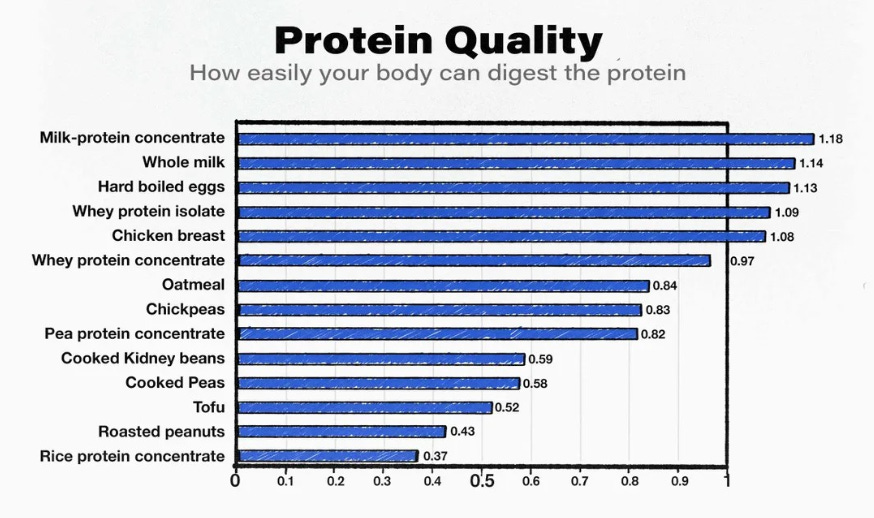· weightlifting · 10 min read
What Is The Easiest Muscle To Build? The Shocking Truth
Are you looking to pack on lean muscle and sculpt your physique? Understanding the factors that affect muscle building and determining the easiest muscles to build can be the key to achieving your fitness goals.
Are you looking to pack on lean muscle and sculpt your physique? Understanding the factors that affect muscle building and determining the easiest muscles to build can be the key to achieving your fitness goals. Genetics, age, diet, and exercise routine all play a significant role in the muscle-building process, and knowing how these factors influence your progress is crucial.
The truth is, there is no “one” easiest muscle to build, there are multiple muscles that build easier than others. One thing to keep in mind is the various factors that impact muscle building, explore the easiest muscles to build, identify the best exercises for muscle growth, examine the importance of rest and recovery, and uncover the timeline for achieving noticeable muscle gains.
Whether you’re a beginner looking to kickstart your muscle-building journey or a seasoned gym-goer aiming to optimize your workouts, this article will provide valuable insights to help you achieve the results you desire.
What are the Factors that Affect Muscle Building?
Muscle building is influenced by various factors, including genetics, age, diet, and exercise routine, which play crucial roles in determining the success of muscular development and growth.
Genetics
Genetics play a substantial role in muscle building, influencing an individual’s muscle growth potential, composition, and overall response to training.
These genetic factors contribute to variations in muscle fiber type, creating differences in strength, endurance, and hypertrophy among individuals. Specific genetic variations affect the production of key proteins involved in muscle development, such as myostatin, which can impact the rate and extent of muscle growth.
Understanding the interplay between genetic predispositions and muscle building outcomes provides valuable insights for personalized training and targeted interventions to optimize muscle growth and performance.
Age
Age is a significant factor in muscle building, impacting aspects such as muscle maintenance, fatigue resistance, and the body’s response to training stimuli.
As individuals age, there is a natural decline in muscle mass and strength, making it more challenging to maintain muscle tissue. Older adults may experience decreased fatigue resistance, leading to quicker exhaustion during physical activities.
The body’s response to training also changes with age, as older individuals may require different training approaches to achieve optimal muscle growth. Understanding these age-related changes is crucial for designing effective exercise and nutrition strategies tailored to the needs of different age groups.
Diet
Diet plays a crucial role in muscle building, providing essential nutrition and potential supplementation to support muscle growth and recovery.
Nutrition is fundamental for muscle development, with protein being a key component for muscle repair and growth. Carbohydrates provide the necessary energy for intense workouts, and healthy fats aid in hormone production. Specific nutrients like vitamin D, calcium, and omega-3 fatty acids support bone health and muscle function.
While obtaining these nutrients from whole foods is ideal, using supplements like protein powders, creatine, and branched-chain amino acids can further enhance muscle growth when consumed as part of a balanced diet.
Exercise Routine
An effective exercise routine is a cornerstone of muscle building, emphasizing strength training and progressive overload to stimulate muscle growth and overcome fatigue barriers. This approach is essential for individuals seeking to enhance their muscular strength and size. By gradually increasing the intensity of the workouts and implementing varied exercises, the muscles are continually challenged, contributing to their growth and development.
Managing muscle fatigue through adequate rest periods, proper nutrition, and hydration plays a crucial role in optimizing the benefits of the exercise regimen. It is imperative to strike a balance between exertion and recovery to achieve maximum results in muscle building.
What is the Easiest Muscle to Build?
Identifying the easiest muscle to build is a subject of interest, with certain muscle groups such as the biceps, triceps, deltoids, quadriceps, glutes, and hamstrings often considered relatively easier to develop compared to others.
Biceps
The biceps are often considered one of the easiest muscles to develop, with targeted exercises contributing to significant muscle development and strength gains.
Incorporating exercises such as bicep curls, hammer curls, and chin-ups into a regular workout routine can effectively target the biceps. Progressive overload, through increasing weights and resistance, is a key strategy for stimulating muscle growth. A balanced diet rich in protein and micronutrients supports muscle recovery and development.
It’s important to note that overall muscle strength also plays a crucial role in biceps growth, as stronger muscles can handle heavier loads, leading to enhanced muscle development.
Triceps
Building the triceps is often considered relatively easier due to the effectiveness of resistance training in toning and defining these muscles.
Incorporating exercises such as tricep dips, tricep kickbacks, and tricep extensions into your workout routine can significantly contribute to the development of well-defined triceps. Utilizing resistance bands, dumbbells, or machines allows for progressive overload, stimulating muscle growth and strength. Focusing on proper form and technique during resistance training is crucial for targeting the triceps effectively.
Consistent resistance training not only enhances muscle tone but also boosts overall arm strength, contributing to a well-rounded upper body physique.
Deltoids
The deltoids are often deemed relatively easier to develop, with targeted exercises contributing to noticeable muscle growth and mass in this muscle group.
Engaging in regular weight training exercises like shoulder presses, lateral raises, and upright rows can significantly build up the deltoid muscles. Incorporating variations such as front raises and bent-over lateral raises further enhances muscle stimulation. Incorporating progressive overload by gradually increasing the weight and intensity of the exercises stimulates muscle growth. It’s also important to ensure adequate rest and recovery to allow the deltoids to heal and grow. Consistency and proper form are essential for maximizing deltoid development.
Quadriceps
The quadriceps are considered relatively easy to develop, with exercises focusing on muscular endurance and hypertrophy yielding noticeable results in this muscle group.
One effective exercise for building quadriceps endurance and size is the squat, which engages the quadriceps, hamstrings, and glutes. Incorporating variations such as front squats and goblet squats can add more diversity to the workout regimen. Lunges, leg presses, and step-ups are excellent choices for targeting the quadriceps.
Implementing progressive overload and adequate recovery are crucial for hypertrophy. It’s essential to maintain proper form and gradually increase the resistance to challenge the muscles, leading to their enhanced growth and strength.
Glutes
Developing the glutes is often viewed as relatively easier, with emphasis on proper muscle care and recovery contributing to their development and toning.
This can be achieved through a variety of exercises such as squats, lunges, deadlifts, and hip thrusts, all of which specifically target the glutes. Incorporating resistance bands and weight training can further enhance muscle development. It’s crucial to allow for adequate rest and recovery between workouts to prevent overtraining and injury, while also focusing on proper nutrition to support muscle growth. Stretching and foam rolling can aid in muscle care, improving flexibility and reducing post-workout soreness, ultimately promoting overall glute health.
Hamstrings
The hamstrings are often considered relatively easier to develop, with a focus on muscle repair and dispelling common myths surrounding their development.
Building strong, well-defined hamstrings is attainable with targeted exercises such as deadlifts, hamstring curls, and hip extensions. To effectively repair and strengthen these muscles, a focus on proper nutrition, rest, and recovery is crucial. It’s important to debunk the myth that only heavy lifting can build hamstring strength, as incorporating a variety of exercises and rep ranges can be equally effective.
Consistent resistance training coupled with adequate protein intake supports muscle growth and repair, ultimately fostering well-developed and resilient hamstrings.
What are the Best Exercises for Building Muscles?
Effective muscle building is facilitated by incorporating the best exercises, including compound movements and resistance training, to target multiple muscle groups and stimulate growth.
Compound Exercises
Compound exercises are among the best for building muscles, engaging multiple muscle groups and eliciting complex physiological responses to promote overall muscle development.
These exercises are highly efficient in activating multiple muscle groups simultaneously, leading to greater overall muscle stimulation and growth. By incorporating movements that engage various muscle groups, compound exercises enhance muscle coordination and overall functional strength. They stimulate the release of growth hormone and testosterone, both of which play crucial roles in muscle hypertrophy. The integration of compound exercises into a workout routine ensures balanced and comprehensive muscle development, resulting in increased strength and improved athletic performance.
Resistance Training
Resistance training stands as one of the best approaches for muscle building, stimulating hypertrophy and addressing muscle fatigue to achieve significant muscular development.
By engaging in regular resistance training, individuals can experience increased muscle mass, strength, and endurance. The gradual overload placed on the muscles during resistance exercises leads to hypertrophy, where muscle fibers grow in size. Incorporating strategies such as progressive overload, proper nutrition, and adequate rest can help overcome muscle fatigue and promote optimal muscle recovery.
This holistic approach not only enhances physical performance but also contributes to overall well-being.
Progressive Overload
Incorporating progressive overload into training regimes is essential for muscle building, fostering continuous growth and enhancing muscular endurance over time.
This technique involves gradually increasing the intensity, duration, or frequency of exercises to continually challenge the muscles, resulting in the adaptation and growth of muscle fibers. By progressively increasing the stress placed on the muscles, individuals can stimulate muscle hypertrophy and develop greater strength and endurance.
Progressive overload is crucial for breaking through plateaus and ensuring sustained improvements in muscle function and performance. It plays a pivotal role in maximizing the effectiveness of workouts, leading to more significant gains in muscle size and overall physical capabilities.
What is the Importance of Rest and Recovery in Muscle Building?
Rest and recovery play integral roles in muscle building, facilitating muscle maintenance and repair processes essential for sustained growth and performance.
These periods of rest allow the muscle fibers to repair and rebuild, leading to increased strength and size. Without adequate rest, the muscles may experience fatigue and become more susceptible to injury, hindering overall progress. Sufficient rest is crucial for hormonal balance and optimal muscle protein synthesis, which are key mechanisms for muscle growth. Integrating rest days into training regimens allows the body to adapt and recover, leading to enhanced performance and long-term muscle development.
How Long Does it Take to Build Muscle?
The timeframe for building muscle varies based on individual factors, including genetics, dedication to training programs, and the specific muscle groups targeted for development.
Genetics play a crucial role in determining an individual’s response to muscle-building efforts. Some people are genetically predisposed to build muscle more quickly, while others may find it requires more time and dedication. The amount of dedication to a structured training program can significantly impact the speed of muscle growth. Consistent and focused training, along with proper nutrition and recovery, can expedite the muscle-building process.
Targeting specific muscle groups with tailored workouts also influences the time it takes to achieve noticeable muscle development.
Frequently Asked Questions
What is the easiest muscle to build?
The biceps are often considered the easiest muscle to build due to their smaller size and ability to respond quickly to weight training.
Is it possible to build muscles quickly?
Building muscles takes time and dedication, but some muscles, such as the biceps, can respond quickly to weight training and show visible results in a shorter period of time.
What exercises are best for building muscles?
Compound exercises, such as squats, deadlifts, and bench presses, are generally considered the most effective for building muscles as they engage multiple muscle groups at once.
Can nutrition affect muscle building?
Yes, a balanced diet with adequate protein is essential for muscle building. Protein provides the building blocks for muscles to grow and repair.
Do genetics play a role in muscle building?
Genetics can play a role in how easily someone can build muscles, but everyone can improve their muscle mass through consistent and proper training.
Is it necessary to lift heavy weights to build muscles?
Lifting heavy weights can help build muscles, but it is not the only way. Using lighter weights with higher repetitions can also be effective for muscle growth, especially for beginners.






